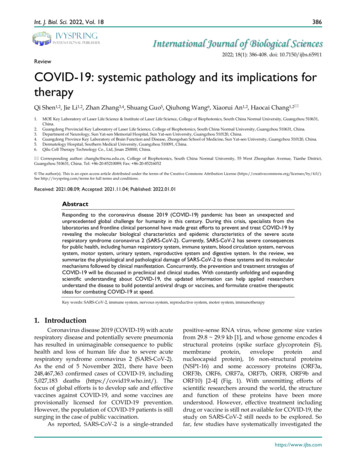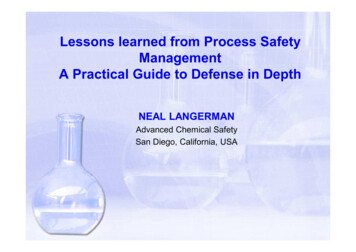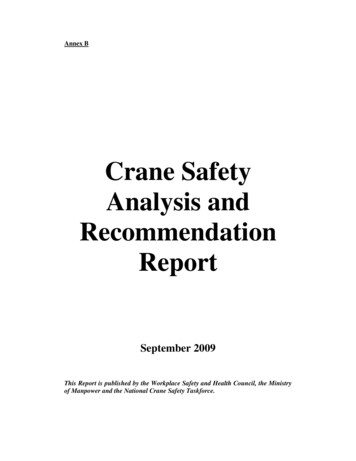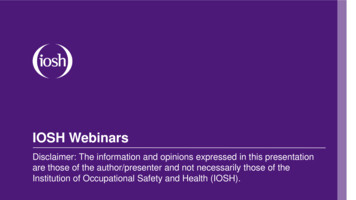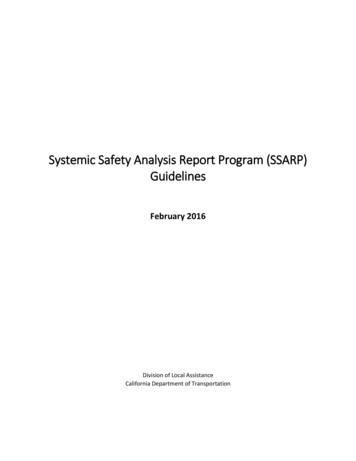
Transcription
Systemic Safety Analysis Report Program (SSARP)GuidelinesFebruary 2016Division of Local AssistanceCalifornia Department of Transportation
SSARP GuidelinesTABLE OF CONTENTS1234Introduction. 21.1Background . 21.2Program Goal . 31.3Program Schedule . 3Funding . 32.1Source . 32.2Matching Requirement . 42.3Reimbursement. 42.4Timely Use of Funds. 4Eligibility . 43.1Applicants. 43.2Location of Study Area. 4Application and Selection Process. 44.1Project Application. 44.2Selection Process . 54.3Application Award. 55Implementation. 56Reporting Requirements . 66.1Executive Summary. 66.2Engineer’s Seal . 76.3Statement of Protection of Data from Discovery and Admissions . 76.4Safety Data Utilized (Crash, Volume, Roadway) . 76.5Data Analysis Techniques and Results . 76.6Highest Occurring Crash Types . 86.7High-risk Corridors and Intersections (Crash History and Roadway Characteristics) . 86.8Countermeasures Identified to Address the Safety Issues . 86.9Viable Project Scopes and Prioritized List of Safety Projects. 86.10 Attachments and Supporting Documentation. 97Resources . 9Caltrans Department of TransportationDivision of Local AssistancePage 1February 2016
1 INTRODUCTIONThese guidelines describe the policy and procedures for implementing the Systemic Safety AnalysisReport Program (SSARP). The guidelines were developed in consultation with the California LocalHighway Safety Improvement Program (HSIP) Advisory Committee which includes representatives from: Federal Highway Administration (FHWA)California Department of Transportation (Caltrans)California Transportation Cooperative CommitteeCalifornia State Association of CountiesLeague of California CitiesRegional Transportation Planning AgencyMetropolitan Planning OrganizationRural County Task Force1.1 BACKGROUNDSystemic analysis is a proactive safety approach that focuses on evaluating an entire roadway networkusing a defined set of criteria. It looks at crash history on an aggregate basis to identify high-riskroadway characteristics, rather than looking at high-collision concentration locations through siteanalysis. Systemic analysis acknowledges that crashes alone are not always sufficient to prioritizecountermeasures across a system. This is particularly true for many local streets and highways in ruralareas with low volumes where crash densities tend to be low and there are few high crash locations, andin urban areas where vehicles interact with vulnerable road users (pedestrians, bicyclists, andmotorcycles).The following are examples of infrastructure improvement countermeasures identified through thesystemic analysis approach:Signalized Intersection Countermeasures Improve signal hardware: lenses, retro-reflective back-plates, mounting, size, and numberProvide protected left turn phase (left turn lane already exists)Install flashing beacons as advance warningCreate directional median openings to allow (and restrict) left-turns and U-turnsInstall pedestrian countdown signal headsInstall advance stop bar before crosswalk (Bicycle Box)Non-Signalized Intersection Countermeasures Add intersection lightingInstall/upgrade larger or additional stop signs or other intersection warning/regulatory signsInstall flashing beacons as advance warningCreate directional median openings to allow (and restrict) left-turns and U-turnsInstall raised medians/refuge islands (Pedestrian/Bike only)Install enhanced pedestrian crossing features, e.g. signs/markings, rapid rectangular flashingbeacon or curb extensions, etc.Caltrans Department of TransportationDivision of Local AssistancePage 2February 2016
Roadway Segment Countermeasures Road diet (striping only)High friction surface treatmentUpgrade signing through Roadway Safety Signing AuditUpgrade pavement markings through Roadway Safety Pavement Marking AuditInstall delineators, reflectors and/or object markersInstall guardrail and impact attenuatorsInstall bike lanesInstall centerline rumble strips/stripesInstall edge line rumble strips/stripesAdditional information on the systemic approach for roadway safety analysis can be found on theFederal Highway Administration’s “Systemic Approach to Safety” webpage.1.2 PROGRAM GOALThe goal of the SSARP is to help local agencies identify safety projects to submit for HSIP fundingconsideration. Through the funding of Systemic Safety Analysis Reports (SSAR), local agencies will beencouraged to evaluate their roadway networks with an approach that has been effective for addressingsafety issues.Although not a prerequisite to applying for HSIP funds, the use of results documented in their SSAR willidentify high benefit-cost ratio safety projects that have been found to be competitive in previous HSIPcycles.1.3 PROGRAM SCHEDULEThe SSARP will be implemented in two phases to facilitate outreach with the Strategic Highway SafetyPlan (SHSP) Regional Summits. The following is a tentative schedule of major milestones for the SSARP:MilestonesPhase 1Phase 2Call for ApplicationsFebruary 2016June 2016Applications Due DateMarch 2016July 2016Awarded Applications PostedApril 2016August 2016*Strategic Highway Safety Plan (SHSP) Regional Summits: February and April 2016.2 FUNDING2.1 SOURCE 10 million of the California HSIP was set-aside and exchanged for state funds from the State HighwayAccount to fund the SSARP. The use of state funds is to increase the participation of underserved localagencies unfamiliar with federal administrative requirements.Caltrans Department of TransportationDivision of Local AssistancePage 3February 2016
2.2 MATCHING REQUIREMENTA local match of ten (10) percent of the total project cost is required for SSARP projects.2.3 REIMBURSEMENTThe SSARP is a reimbursement program for eligible costs incurred. Reimbursement is requested throughthe invoice process detailed in Chapter 5, Invoicing, of the Local Assistance Procedures Manual (LAPM).Costs incurred prior to funding allocation are not eligible for reimbursement.2.4 TIMELY USE OF FUNDSThe project sponsor must complete the study and the SSAR report within thirty-six (36) months of thefunding allocation. The Final Report of Expenditures and the final invoice must be submitted within six(6) months of the report completion. If these requirements are not met, the project sponsor must payback the state funds expended.3 ELIGIBILITY3.1 APPLICANTSCities and counties in California that are able to comply with all the laws, regulations, policies andprocedures required to enter into a State-only Funds Master Agreement are eligible to apply for SSARPfunding. Refer to Chapter 4, Agreements, of the LAPM for guidance and procedures on MasterAgreements.3.2 LOCATION OF STUDY AREAFunds are eligible for the systemic safety analysis of any roadways publically owned or on tribal lands.4 APPLICATION AND SELECTION PROCESS4.1 PROJECT APPLICATIONSection 1.3 provides a tentative program schedule. Actual calls-for-applications will be announced onlineat the Division of Local Assistance (DLA) HSIP website. The Application Form, its instructions and otherdocuments related to SSARP are also available at this website. The completed applications aresubmitted to the District Local Assistance Engineer (DLAE).Funding for proposed study areas may only be requested once (i.e. funding requests for a study areacannot be requested in multiple applications).4.1.1 Maximum Fund RequestEach local agency may submit only one application requesting a maximum of 250,000 SSARP funds, ineither Phase 1 or Phase 2 call for applications. Alternatively two or more local agencies may choose toCaltrans Department of TransportationDivision of Local AssistancePage 4February 2016
submit a joint application through partnership. A maximum of 500,000 of SSARP funds can berequested per joint application.Additional funds beyond the maximum amount will need justification and approval by the Office ofBridge, Bond, and Safety Programs (OBBSP) in the DLA.4.1.2 Award PhasesFunds will be awarded in two phases to facilitate outreach with the Strategic Highway Safety Plan (SHSP)Regional Summits. Refer to the Section 1.3, Program Schedule, for dates of award.4.2 SELECTION PROCESSIf requests exceed available SSARP funding, priority will be given to applications from local agencies that Have the highest numbers of fatality and severe injury (F SI) (based on the most recent /available data from California Highway Patrol (CHP) Statewide Integrated Traffic RecordsSystem (SWITRS) );Have the highest crash rates of F SI per 100 Million Vehicle Miles Traveled (MVMT) ;Have never submitted applications in Cycle 5 through Cycle 7 HSIP calls-for-projects; orHave submitted applications but have had no projects selected for federal funding in Cycle 5through Cycle 7 HSIP calls-for-projects.There are no order or priority associated with the above selection criteria. When necessary, the LocalHSIP Advisory Committee may review the priority ranking of the applications and approve for funding.4.3 APPLICATION AWARDThe OBBSP will post the list of awarded applications on the DLA HSIP website. A notification letter willbe sent to the sponsor of each successful application.5 IMPLEMENTATIONIn addition to the applicable provisions of the LAPM, local agencies will need to follow theimplementation steps in this section. Any work done prior to the funding allocation is at the cost of theproject sponsor and will not be eligible for reimbursement.1. When ready to proceed with their study, the project sponsor submits the following documentsto their DLAE to request an allocation of funds:a. A letter of request for SSARP Funding Allocationb. Finance Letterc. Copy of the SSARP Applicationd. Copy of the award notification letter from Caltrans DLATemplates of the above (a) and (b) are available for downloading at the DLA HSIP website.As an SSARP project utilizes state funds for a study only and no right-of-way or construction isinvolved, the allocation will be under Preliminary Engineering (PE) phase. No right-of-way orenvironmental documents are required for the allocation request.Caltrans Department of TransportationDivision of Local AssistancePage 5February 2016
The amount of state funds requested should not exceed the amount of funds awarded.Additional funds shall not be allocated without the written approval from the OBBSP.2. The DLAE reviews the allocation request package for consistency with the application, assignsproject numbers and Advantage IDs, and forwards the request to the DLA HQ Area Engineer forallocation. An allocation request will be rejected if the scope or request amount does not matchthe application. Any change to the scope of work needs to be approved by the OBBSP inadvance of the allocation.3. After receipt of a complete request package, the DLA HQ Area Engineer will:a. Prepare an allocation letter which will serve as the authorizing document for the projectsponsor to begin reimbursable work. A copy of the allocation letter and Finance Letterwill be distributed to the project sponsor, DLAE, the OBBSP, and Local ProgramsAccounting (LPA). Note that any work performed prior to the effective date of theallocation letter is not eligible for reimbursement.b. Prepare a Program Supplement Agreement (PSA) and send it to the local agency forexecution. If a local agency does not have a “State-only Funds Master Agreement” onfile with Caltrans, one will need to be executed in conjunction with the PSA.4. The project sponsor invoices Caltrans (Refer to LAPM Chapter 5 and Exhibit 5-C). In order for theproject to remain active, the project sponsor must submit invoices to Caltrans at least every six(6) months after funds are allocated.5. The analysis and the SSAR report must be completed within thirty-six (36) months of allocation.The project sponsor must submit the final report (refer to Section 6, Reporting Requirements) tothe DLAE. The DLAE reviews and verifies that the report has been completed in accordance withthe approved scope and the program guidelines, and then forward a copy of the report to theDLA OBBSP.6. The project sponsor must submit the Final Invoice (LAPM Exhibit 5-C) and the Final Report ofExpenditures (LAPM Exhibit 17-M) to the DLAE within six (6) months of the report completion.The DLAE reviews the submittals for compliance and then forward the package to LocalPrograms Accounting (LPA) for processing.7. The LPA and the DLA close out the project.6 REPORTING REQUIREMENTSTo be eligible for final reimbursement, the SSAR must identify and prioritize future safety projects. If nosafety projects are identified, reasons must be documented within the SSAR. The following sections anddiscussions must also be included in the final report.6.1 EXECUTIVE SUMMARYThis section should include the applicant’s objectives and focus for the SSAR and a brief summary of themajor results. Include discussion on what methodologies were used to limit the data analysis andstudies to stay within the funding limits. Other high-level discussions may include crash trends, corridorsidentified, countermeasures considered, conceptual projects identified, benefit-cost ratios for theprojects, etc.Caltrans Department of TransportationDivision of Local AssistancePage 6February 2016
6.2 ENGINEER’S SEALChapter 7; Article 3; Section 6735 of the Professional Engineer's Act of the State of California requiresengineering calculation(s) or report(s) be either prepared by or under the responsible charge of alicensed civil engineer. Analysis must be completed under this provision and the SSAR must be signedby the local agency transportation manager and signed/stamped by a licensed civil engineer.The engineer’s signature must be accompanied by a statement similar to the following:By signing and stamping this Systemic Safety Analysis Report, the engineer is attesting to thisreport's technical information and engineering data upon which local agency'srecommendations, conclusions, and decisions are made.6.3 STATEMENT OF PROTECTION OF DATA FROM DISCOVERY AND ADMISSIONSIt is recommended that applicants include the following language in the SSAR which is from Section 148of Title 23, United States Code [23 U.S.C. §148(h) (4)] about reports prepared under State’s StrategicHighway Safety Plan and HSIP:REPORTS DISCOVERY AND ADMISSION INTO EVIDENCE OF CERTAIN REPORTS, SURVEYS, ANDINFORMATION—Notwithstanding any other provision of law, reports, surveys, schedules, lists, ordata compiled or collected for any purpose relating to this section, shall not be subject todiscovery or admitted into evidence in a Federal or State court proceeding or considered forother purposes in any action for damages arising from any occurrence at a location identified oraddressed in the reports, surveys, schedules, lists, or other data.6.4 SAFETY DATA UTILIZED (CRASH, VOLUME, ROADWAY)Applicants are required to analyze at least three (3) years of the most current crash data. Crash datafrom their own crash database, the California I-SWITRS database, or UC Berkeley Transportation InjuryMapping (TIMS) are recommended.Applicants should consider the guidance in Section 2 of the Local Roadway Safety Manual (LRSM) tocomplete this section of the SSAR.6.5 DATA ANALYSIS TECHNIQUES AND RESULTSCrash trends and crash concentrations should be analyzed based on overall numbers, identifying theleading causes of fatalities and severe injuries. In addition, applicants are encouraged to identify crasheson a ‘rate’ basis and compare the results of numbers vs. rates.Applicants are not expected to analyze all of the individual crashes, crash locations, and/or crash types.The following are examples of how local agencies can focus the scope of the SSAR: Counties with a large percentage of High Risk Rural Road (HR3) eligible roadways may choose tofocus on identifying and prioritizing future HR3 eligible safety projects.Cities and counties with primarily urban roadways may choose to identify and prioritize futureurban Highway Safety Improvement Program projects for motorized and/or non-motorizedusers.Caltrans Department of TransportationDivision of Local AssistancePage 7February 2016
Cities and counties with a wide mixture of roadways may choose to focus on only rural or urbanroadways or a mix of roadway and user types at a limited number of locations.Applicants should consider the guidance in Section 3 of the LRSM to complete this section of the SSAR.6.6 HIGHEST OCCURRING CRASH TYPESApplicants can focus on their top 3 to 10 crash types responsible for the fatalities and severe injuriesoccurring on their roadway network. If an applicant chooses to focus on specific “high-risk corridors andintersections,” they are still expected to briefly review and discuss their top crash types occurring on theoverall network.Applicants should consider the guidance in Section 3 of the LRSM to complete this portion of the SSAR.6.7 HIGH-RISK CORRIDORS AND INTERSECTIONS (CRASH HISTORY AND ROADWAY CHARACTERISTICS)Applicants can choose to focus on their top 3 to 10 high-risk corridors and top 5 to 20 intersectionsresponsible for fatalities and severe injuries occurring on their roadway network. If an applicant choosesto focus on specific crash types, they are still expected to briefly review and discuss their high-riskcorridors and intersections on the overall network.Applicants should consider the guidance in Section 3 of the LRSM to complete this portion of the SSAR.6.8 COUNTERMEASURES IDENTIFIED TO ADDRESS THE SAFETY ISSUESApplicants are required to use crash reduction factors provided in the LRSM to identify potential lowcost systemic countermeasures that mitigate the local agencies’ primary crash type trends. In addition,applicants should use their crash concentrations (system-wide, corridors, and spot locations) to identifythe countermeasures with a high likelihood of addressing the crashes that are appropriate for thecharacteristics of the roadway.Applicants should consider the guidance in Section 4 of the LRSM to complete this section of the SSAR.6.9 VIABLE PROJECT SCOPES AND PRIORITIZED LIST OF SAFETY PROJECTSOnce the crash areas, trends, and corresponding systemic countermeasures have been identified, localagencies need to create preliminary safety project scopes. It is recommended that the applicant focuson finding the ideal balance between collision analyses on a systemic basis while also addressing highcrash locations. For the lowest cost improvements, like signing and striping, it may be an appropriategoal to have the entire roadway network eventually upgraded to a minimum level.In contrast, the costlier systemic countermeasures may only be feasible to install at higher crashlocations/characteristics on a corridor-by-corridor basis. Estimating total-project costs and calculatingBenefit/Cost (B/C) ratio are the next steps in prioritizing the list of safety projects. Cost estimates maybe based on individual construction items or lump sum project costs per mile or per location. Forcalculating the B/C ratio of a project, the TIMS B/C Calculation Tool from the University of California,Berkeley Safe Transportation Research and Education Center website should be used. This tool relies onexisting crashes to calculate a project’s expected benefit.Caltrans Department of TransportationDivision of Local AssistancePage 8February 2016
Applicants should consider the guidance in Section 5 of the LRSM to complete this section of the SSAR.6.10 ATTACHMENTS AND SUPPORTING DOCUMENTATIONAttach and reference supporting documents as appropriate to meet their long-term intended use for thereport.7 RESOURCESSSARP Funding Application: http://www.dot.ca.gov/hq/LocalPrograms/HSIP/apply now.htmCaltrans Local Roadway Safety Manual (LRSM): .pdfLocal Assistance Procedures Manual (LAPM): mCalifornia Strategic Highway Safety Plan (SHSP): http://www.dot.ca.gov/hq/traffops/shsp/California I-SWITRS: orts.jspUC Berkeley Transportation Mapping (TIMS): http://tims.berkeley.eduFHWA – A Systemic Approach to Safety: http://safety.fhwa.dot.gov/systemic/index.htmFHWA Local and Rural Road Safety Program: http://safety.fhwa.dot.gov/local rural/FHWA Systemic Project Selection Tool: WA Road Diets Informational Guide: http://safety.fhwa.dot.gov/road diets/info guide/Caltrans Department of TransportationDivision of Local AssistancePage 9February 2016
Road diet (striping only) High friction surface treatment . Additional funds beyond the maximum amount will need justification and approval by the Office of Bridge, Bond, and Safety Programs (OBBSP) in the DLA. . b. Prepare a Program Suppl


